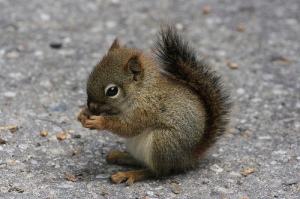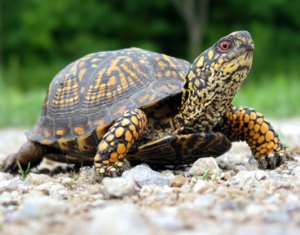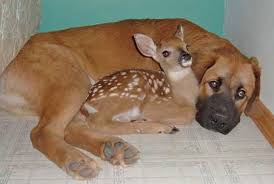Aww, look, a baby squirrel! He’s all alone, and he’s so cute! Why don’t we take him home and raise him, then we can let him go when the kids go back to school in the fall?
The state of Indiana is currently soliciting comments for a bill which would make the above scenario legal, creating an uproar among those licensed to care for injured and orphaned wildlife.
Wildlife rehabilitators have to jump through hoops to get our licenses. I live in New York, where in order to rehab mammals, reptiles, amphibians, and non-native birds (starlings, house sparrows, pigeons) you have to pass a test covering the natural history of all local species, as well as their emergency care, nutrition, restraint techniques, wound management, parasitic infections, epizootic/zoonotic diseases, and release criteria.
In other words, even if you only want to take care of squirrels, you still have to know everything about turtles. Are we tired yet?
If you want to rehab migratory birds, the hoops triple. After passing the state test you have to write an autobiographical summary of your avian experience, including the length of your apprenticeship with a licensed rehabilitator. You have to submit diagrams and photographs of your facilities, specify where you will be obtaining species-specific food, and gather what seem like thousands of letters of recommendation.
Indiana has proposed a bill which would allow the public to bypass all this and wing it for 90 days, which is when the finders would have to hand whatever unfortunate creature they’ve taken in – if it were still alive – to someone with a license, or else simply take it to the nearest field and give it the boot.
So far this would apply only to mammals, but it’s a slippery slope. And if it were to become law, other states could follow.
Every rehabber has horror stories about the birds/animals they’ve received from John Q. Public after he’s kept them for awhile. The fledgling hawk fed nothing but hamburger, whose bones are so brittle from lack of calcium they break when she tries to stand; the young deer who just loves the whole family, including the dog, but who has now started jumping over the backyard fence and roaming the neighborhood; the baby raccoon who has been sleeping with the kids but is now sort of sick, so can somebody fix her and give her back to us, please?
In each case, the finders receive their warm fuzzies at the cost of the animal’s life. Metabolic Bone Disease is normally irreversible; and if the hawk can’t stand, she certainly can’t fly. The imprinted, soon-to-be-hormonal deer has no idea he’s a deer, or that most humans and large dogs are not so friendly. The raccoon – as the parents are always horrified to learn – might have rabies, so she has to be euthanized and tested.
Moral of the stories: get thee (and thy critter) to a rehabber.
Many adults credit their love of wildlife to childhoods spent disappearing into the woods and returning with all kinds of injured/orphaned wild things, even though the wild things usually went belly up within a few days. A generation ago, however, both wildlife rehabilitation and regulation were in their infancy. Knowledge (and the ability to share it) has made a quantum leap. Wildlife rehabilitators are no longer isolated, well-meaning individuals doing the best they can out of their garage; we’re professionals who work closely with skilled veterinarians, share our hard-won expertise with each other over the internet, and on occasion, take credit for helping to restore an endangered species.
We know our limits (and how to feed nestling pigeons so they don’t up like this). Shouldn’t the public?
“We in Indiana have all worked hard to help the public see us as a resource, and work with us to improve the situation for wildlife,” says Patti Reynolds, President of the Indiana Raptor Center. “We don’t need our hard work undone by ignorance and pie-in-the-sky laws.”
So what do you do if your six-year-old finds a baby bunny, and she can’t bear to part with it? Or what if it happens to you, and you’re forty-five?
Six is not too early, and forty-five is not too late, to learn that you can’t always get what you want. (I want a 1972 Ferrari 246GTS, but odds are I’m not going to get one.) Explanations are simple: only a mother rabbit or a highly trained rehabilitator has a chance of raising and releasing a healthy wild bunny. And just like humans, if a wild animal is injured it needs to be treated by a licensed medical person, not a well-intentioned accountant, plumber, or six year old child.
But then, how do you get your wildlife fix?
Rehabbers always need help. If you fall in love with the bird you’ve rescued, deliver him to a rehabber and ask if you can volunteer. Work. Learn. With luck, you might get to see your bird released back to the sky, instead of spending his shortened life in a box in your bathroom, improperly fed and in pain. Bring your child to fundraisers, to sanctuaries, to demonstrations with trained education animals like Xena, above. Teach your child to do the right thing even if it makes her a little sad, because help without knowledge is no help at all.
“Trust me,” says Kathy Uhler, co-founder of the Pocono Wildlife Rehabilitation and Education Center in Stroudsburg, PA. “I know nothing about kids. If I found a child wandering around the mall and tried to take him home and care for him, I’d release him in much worse shape than I found him.”







I am sure with you on this. I do homecare for Project Wildlife in San Diego. I got a young mockingbird in that had degenerative bone disease that I had to put down. It’s legs were twisted up around its head and the wings were warped. The person that raised it had no idea that they need direct sunlight each day. Sad. I have also gotten in birds coated in dried food. Right now I am raising baby pigeons brought in by a good samaritan who rescued them from some yahoos working under a pier. They took them from the nests and wanted to throw them in the water, but were stopped by the kind person. Noisy little buggers, aren’t they? The post I have not seen lately looking back through is the the one about the vulture that trashed your house. It had me laughing so hard I cried. (sorry about that- I wasn’t the one who had to clean up the vomit) Do you still have that one? I would love to read it again. I enjoy your posts. Keep them coming.
Hi Charlene,
Good for you, working with Project Wildlife. Poor mockingbird … and glad there are good samaritans left in the world. That vulture story really was funny, it happened not to me but to a friend. It’s called “Vulture Follies” and I don’t know why it’s not going through, I’m going to see if I can repost it. Thanks for writing!
Hi Robin, thanks for the input from a squirrel rehabber’s point of view. I can imagine the damage a squirrel could do – like a furry woodpecker. Sometimes people just don’t think things through….
I found a baby squirel I raised it wright I followed instructions from a Rehab but I got attached to it and did not want to let it go, I would take it out of the cage witch I kept outside everyday brought him in the house and played with it for an hour on the weekend s I would put the open cage next to a 30th tall mango tree and watch him for two hours running and jumping up the tree then I would put him back in the cage. One Saturday I put him out on the tree and left him alone for about two hours we to the store. When we got back he was gone the whole family was sad ,and I cried thinking of the memories. I was just wishing that he left with another squirel and that a Hawk did not get him.One morning after two days gone. I was at work My wife went out by the mango tree and he was there he jump on her my wife just walked into the house and we had him again I was so happy, cause even now and then I would get teary eyes thinking of the memories from milk to food.I was thinking of buying a big cage and keeping it as a pet.but I was reading that it not right or good for them I kept him for about two weeks after recapture. Today we opened the door of his cage and left it opened and let him leave on its own he got out and went for the mango tree later on to the neighbors trees and then out of sight. I going to leave his cage opened with food in it and watching out for it I hope he comes back so I can see him and feed him. That’s the story and I’m all teary-eyed right now I will have to get over it I’m asking God for his help.
Pedro, where is your location? Are you in the US? Not sure there are 30 foot mango trees here. Most of the information on the internet is bad and false. Squirrels cannot be raised alone without imprinting. If they grow up surrounded by no one but humans, they will not look to other squirrels for companionship. They will end up alone, sort of a pet but not a pet, and will have no idea what predators are. Please look down at the response from Robin Goulter, who is a licensed squirrel rehabber.
I live in miami I found the baby squriel under a small tree in my front yard moving slow he had fur and eyes open I would say around six weeks old kept it warm hydrated it with petilite then fed it so sobilac until it started eating would feed Henrys Healthy pet baby squirel food nuts and greens till his realise He came back around on the second day and I fed it today is the third day and it hasn’t come yet. I’M just sacred that a Hawk gets its there hawks around here.I just wish him the best. The other option would of been getting areal big cage and keeping it. But I read they prefer the wid.